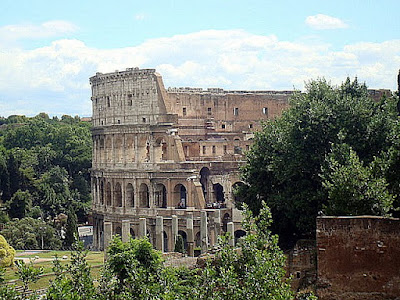These pictures are some of my favorite from Rome because they deal with one of my favorite subjects - ancient history. We visited the Roman Forum and the Colosseum. I've had a fascination with ancient life since middle school. I took world history in the sixth grade and fell in love with tales of Mesopotamia and the ancient Egyptians, Romans, and Greeks. Additionally, I began taking Latin in the seventh grade and we studied ancient Roman life. Seeing some of the sites I have fancied since I was younger gave me chills. Being surrounded by things so old, yet still so real, gives me a feeling that I just can't explain. It was, for a lack of a better word, magical.
One note about the Roman Forum: things aren't labeled as well as they tend to be in most heavily trafficked historic sites. For the most part, I knew I was looking at something extremely cool, but not exactly sure of origin or purpose.


I like this shot - you see ruins, litter, and flowers. Life, much?

I like this view as well. You have part of the center of ancient Rome in the foreground and the more modern capitol building of Italy (akin to our White House) in the background.


The Temple of Antoninus and Faustina, construction dating back to year 141. The building was converted to a Roman Catholic church as early as the 7th century.

The Temple of Romulus, one of Rome's fabled founders. The structure was Christianized in 527 and was known as the basilica Santi Cosma e Damiano.

You can climb to the top of Palantine Hill and experience a great view of the Roman Forum. Included in this shot is the Temple of Castor and Pollux (three columns to the left) and the Arch of Septimius Severus (above the temple), dedicated in 203.

Another shot of the Forum from Palantine Hill.

You can see the Colosseum...our next stop!

Most people are familiar with the historical significance of the Colosseum, or at least have heard stories of the bloody gladiator fights that happened within its walls.

Yes, I was actually there!

The interior of the Colosseum. The center oval-shaped area was actually once covered and part of the underground area where animals and gladiators were kept before being sent into the arena.

Ancient stadium seats, from which Roman citizens delighted in the horrific battles going on in the arena.

From the inside looking out. An interesting comparison of the ancient Roman structure with the more modern buildings (and even a double-decker tour bus!) just a stone's throw away. The holes in the stone of the Colosseum are actually from where scaffolding was built during the original construction of the amphitheater.

Many ancient paintings and carvings exist throughout the Colosseum. Most of them depict the gladiators themselves and battle scenes, but this particular scene is actually a map of the Colosseum (then called the Flavian Amphitheater). Also, in the bottom left corner is a depiction of the Crucifixion.

A close-up of the Crucifixion scene that was painted high above my head inside of the Colosseum.
At last, this ends my pictorial of Rome! Three more cities left - Florence, Venice, and Milan. I wonder how long it will be before I make those updates? I do plan on making this blogging a regular thing, but I feel as if I must finish updating my trip pictures before I start discussing my everyday musings and occurrences.









































